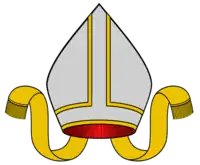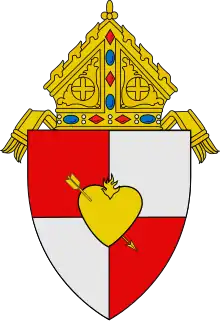Joseph Patrick Hurley
Joseph Patrick Hurley (January 21, 1894 – October 30, 1967) was an American prelate of the Roman Catholic Church. He served as Bishop of St. Augustine from 1940 until his death in 1967. He also held diplomatic posts in Europe and Asia.
| Styles of Joseph Hurley | |
|---|---|
 | |
| Reference style | The Most Reverend |
| Spoken style | Your Excellency |
| Religious style | Monsignor |
| Posthumous style | none |
Early life and education
Joseph Hurley was born in Cleveland, Ohio, one of nine children of Michael and Anna (née Durkin) Hurley.[1] His parents were both Irish immigrants; his father was originally from County Mayo, and his mother from Sligo.[2] Hurley received his early education at Holy Name School from 1901 to 1909, and then attended St. Ignatius High School until 1912.[1] He was the only one among his siblings to continue his education past age 16.[2] He applied to West Point, for which he was nominated by U.S. Representative Robert J. Bulkley before it was discovered that Hurley was not an actual resident of Bulkley's 21st congressional district.[2]
Hurley attended John Carroll University in Cleveland from 1912 to 1915.[1] At John Carroll, he was president of the College Debating Society and the speaker at the commencement ceremony.[2] He also played football for the Geiger Clothes Company team, earning the nickname "The Breezer."[2] He began his studies for the priesthood at St. Bernard's Seminary in Rochester, New York, and was assigned to further theological studies at St. Mary's Seminary in his native Cleveland in 1917.[1] During his summer vacations at St. Mary's, he worked as a naval observer in Sandusky.[2]
Priesthood
On May 29, 1919, Hurley was ordained a priest by Bishop John Patrick Farrelly at the Cathedral of St. John the Evangelist.[3] His first assignment was as an assistant pastor at St. Columba's Church in Youngstown, where he remained for four years.[1] In 1923, he received an interim assignment to St. Philomena's Church in East Cleveland.[1] Later that year, he was appointed to Immaculate Conception Church in Cleveland.[1]
In 1927, Hurley accepted an offer to serve as secretary to Archbishop Edward Mooney, his former professor at St. Mary's Seminary and now Apostolic Delegate to India.[2] He later accompanied Mooney to Japan when he was transferred to the Apostolic Delegation there in 1933.[1] Following Mooney's return to the United States as Bishop of Rochester, Hurley served as chargé d'affaires of the Apostolic Delegation in Japan from 1933 to 1934.[1] During this period, he helped resolve a conflict that arose between Japan and Canada after the newspapers in Kagoshima accused Canadian Catholic missionaries of conducting spying operations on the fortified islands off Kagoshima Bay.[2]
Hurley was named a Domestic Prelate by Pope Pius XI in 1934.[1] That same year, he became the first American to serve as an official of the Vatican Secretariat of State.[1][4] During his work at the Secretariat of State, he acted as a liaison between the Holy See and the American Catholic hierarchy.[5] He thus played an influential role in shaping the Vatican's policy towards Father Charles Coughlin, a controversial Michigan priest and radio personality.[2]
Episcopacy
On August 16, 1940, Hurley was appointed the sixth Bishop of St. Augustine, Florida, by Pope Pius XII.[3] It was believed by some that his appointment was made in order for him to remain in contact with the ailing Myron Charles Taylor, the American emissary to the Vatican.[6] Others believed the appointment was a punishment; Hurley had become a critic of the wartime policy of the Vatican, believing Pope Pius XII was overly fearful about communism and not fearful enough about Nazism.[2] He received his episcopal consecration on the following October 6 from Cardinal Luigi Maglione, with Archbishops Celso Costantini and Clemente Micara serving as co-consecrators, at the chapel of the Pontifical Urbaniana University in Rome.[3][7] Returning to the United States, he was installed as Bishop of St. Augustine on November 26 of that year.[3] The bishop was instrumental in building up the Diocese, which encompassed all of Florida at the time. Bishop Hurley, according to one retired priest, would fly around the state and locate property where the several new interstates were being planned. Hurley would buy up the properties to established church parishes for the future. His vision allowed the Catholic Church to grow rapidly throughout the years.
Before the attack on Pearl Harbor, Hurley was considered the most outspoken interventionist among the American Catholic bishops.[4] He made enemies among isolationist Catholic clergy and laity by labeling the Nazi Party "public enemy No. 1" of the United States and the Catholic Church.[4] He declared, "The foe of all we love, both as Americans and as Catholics, is the Nazi. Communism is still our enemy but ... in point of urgency if not in point of teaching, communism has now ceded its primacy to national socialism."[8] In an editorial in his diocesan newspaper in 1943, he became the only Catholic bishop to issue a clarion call to Catholics to speak out against the extermination of the Jews taking place in the Nazi concentration camps, claiming that "the very basis of the Roman Catholic faith" compelled Catholics to challenge the "orgies of extermination" being perpetrated against the Jews.[2]
During World War II, Hurley aligned himself with the U.S. Department of State and began to act under the direction of government officials.[2] His efforts were largely composed of black propaganda, the use of false source attributions.[2] In a radio address in July 1941, he expressed his belief that President Franklin D. Roosevelt alone should decide upon U.S. entry into the war, saying, "It is up to him to safeguard the interests of the nation in times of great emergency. ...The problem [of entering the war] should be left to the Commander-in-Chief, who alone ... is capable of bringing us safely through."[9] These remarks drew sharp criticism from Archbishop Francis Beckman, who subsequently denounced the "dictatorship pseudo-officially canonized by a brother cleric."[10] Hurley described the Allied bombing of Rome as a "tragically mistaken decision," and predicted that "much of our national unity, much of the respect we enjoy abroad now lie with San Lorenzo, in ruins."[11] He also opposed the idea that the United States should ally with Germany to oppose the Soviet Union.[4]
In 1945, in addition to his role as Bishop of St. Augustine, Hurley made a return to the papal diplomatic service and was appointed by Pius XII as regent ad interim to Yugoslavia.[12] He thus became the first American to be raised to the equivalent rank of a nuncio.[12] Relations between the Vatican and Yugoslavia had been deteriorating following the end of the war; the new communist government had been accused of murdering priests and the Church was charged with "obstructionist" activity.[4] During his five years in Yugoslavia, Hurley negotiated with Marshal Josip Broz Tito and worked closely with U.S. officials.[2] In 1946, he represented Pius XII at the show trial of Archbishop Aloysius Stepinac by Marshal Tito for "crimes against the people."[13] However, his relationship with Pius became strained after Hurley expressed his opposition to both the Vatican's policy towards Marshal Tito and to the removal of Archbishop Stepinac from his post in Croatia.[2]
In 1949, Hurley was relieved of his diplomatic post in Yugoslavia, and was given the personal title of Archbishop on August 14 of that year.[3] Between 1962 and 1965, he attended all four sessions of the Second Vatican Council.[3]
Hurley became ill while attending the Synod of Bishops in Rome, and returned to Florida for treatment.[4] After being nominated on July 1, 1966, he served on the St. Augustine Restoration and Preservation Commission, which would be renamed the Historic St. Augustine Preservation Board in 1970.[14] He later died at Mercy Medical Center in Orlando, at age 73.[4]
Notes
- Curtis, Georgina Pell (1961). The American Catholic Who's Who. XIV. Grosse Pointe, Michigan: Walter Romig.
- Gallagher, Charles R. (2008). Vatican Secret Diplomacy: Joseph P. Hurley and Pope Pius XII. New Haven: Yale University Press.
- "Archbishop Joseph Patrick Hurley". Catholic-Hierarchy.org.
- "Archbishop Joseph P. Hurley, Former Vatican Envoy, Dead; Leader of Diocese in Florida Served as Papal Nuncio in Yugoslavia After War". The New York Times. October 31, 1967.
- "NAMED TO VATICAN POST; Mgr. Hurley of Cleveland Becomes Aide in State Secretariat". The New York Times. November 17, 1934.
- "Diplomats on the Move". Time Magazine. September 2, 1940.
- "HURLEY BECOMES BISHOP; Consecrated in Rome as Prelate of St. Augustine, Fla". The New York Times. October 7, 1940.
- "Prelates for Britain". Time Magazine. May 12, 1941.
- "Bishop Speaks". Time Magazine. July 14, 1941.
- "Brother Against Brother". Time Magazine. August 4, 1941.
- "Unusual Affliction". Time Magazine. August 2, 1943.
- "The Former Bishops of the Diocese of Saint Augustine". Roman Catholic Diocese of St. Augustine.
- "Aid for the Archbishop". Time Magazine. October 14, 1946.
- Brewer, Bradley (June 20, 1967). "Letter from Bradley Brewer to Archbishop Joseph Hurley". Governor's House Library, University of Florida Historic St. Augustine.
References
- Gallagher, Charles R. 2008. Vatican Secret Diplomacy: Joseph P. Hurley and Pope Pius XII. New Haven and London: Yale University Press.
External links
| Catholic Church titles | ||
|---|---|---|
| Preceded by Patrick Joseph Barry |
Bishop of St. Augustine 1940–1967 |
Succeeded by Paul Francis Tanner |

